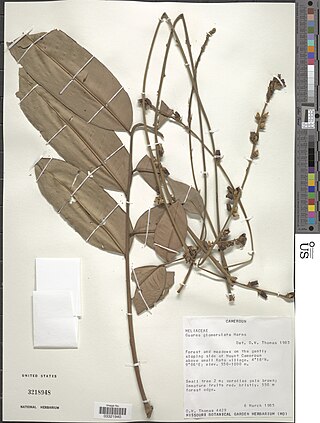
Leucaena is a genus of flowering plants in the mimosoid clade of the subfamily Caesalpinioideae of the family Fabaceae. It contains about 24 species of trees and shrubs, which are commonly known as leadtrees. They are native to the Americas, ranging from Texas in the United States south to Peru. The generic name is derived from the Greek word λευκός (leukos), meaning "white," referring to the flowers.

Albizia lebbeck is a species of plant in the family Fabaceae, native to the Indian subcontinent and Myanmar. It is widely cultivated and naturalised in other tropical and subtropical regions, including Australia. Common names in English include siris, Indian siris, East Indian walnut, Broome raintree, lebbeck, lebbek tree, frywood, koko and woman's tongue tree. The latter name is a play on the sound the seeds make as they rattle inside the pods. Siris is also a common name of the genus Albizia.

Pseudalbizzia inundata is a perennial tree native to South America. Common names include maloxo, muqum, paloflojo, timbo blanco, timbo-ata, and also "canafistula" though this usually refers Cassia fistula.
Pseudalbizzia buntingii is a species of plant in the family Fabaceae. It a tree found only in Zulia state of Venezuela.
Pseudalbizzia burkartiana is a species of tree in the family Fabaceae.
Pseudalbizzia decandra is a species of flowering plant in the legume family, Fabaceae. It is endemic to Brazil, where it occurs in the forests of the Amazon River valley and along its tributaries.
Pseudalbizzia edwallii is a species of plant in the family Fabaceae. It is native to northeastern Argentina and southeastern and southern Brazil.
Pseudalbizzia glabripetala is a species of flowering plant in the family Fabaceae. It is a tree native to Guyana, Venezuela, and Roraima state of northern Brazil.
Parasenegalia vogeliana is a species of flowering plant in the family Fabaceae. It is a liana native to Hispaniola, Puerto Rico, and the Lesser Antilles.
Pseudalbizzia pistaciifolia is a species of plant in the family Fabaceae. It is found in Colombia, Ecuador, and Venezuela.

Hydrochorea is a genus of flowering plants in the family Fabaceae. It includes 11 species native to Central and South America and west and west-central Africa. It belongs to the mimosoid clade of the subfamily Caesalpinioideae.

Pithecellobium is a genus of flowering plants in the family Fabaceae. It includes approximately 23 species from the tropical Americas, ranging from Mexico to Peru and northern Brazil, including the Caribbean Islands and Florida.

Abarema alexandri is a species of plant of the genus Abarema in the family Fabaceae. It is endemic to Jamaica, where it can be found in woodland or thicket on limestone soils.

Cordia dichotoma is a species of flowering tree in the borage family, Boraginaceae, that is native to the Indomalayan realm, northern Australia, and western Melanesia.
Cercocarpus fothergilloides is a Mexican plant species in the rose family. It is widely distributed in northern and eastern Mexico, from Tamaulipas and Coahuila south as far as Oaxaca.
Pseudalbizzia is a genus of flowering plants in the pea family (Fabaceae). It includes 17 species which are native to the tropical Americas, from Mexico to northern Argentina.

Prestoea acuminata is a species of palm tree native to Central America, the West Indies and South America.

Neoguarea glomerulata is a species of flowering plant in the family Meliaceae. It is a tree or shrub native to west-central tropical Africa, ranging from southern Nigeria through Cameroon, Equatorial Guinea, Gabon, Republic of the Congo, and Democratic Republic of the Congo. It is the sole species in genus Neoguarea. It grows in lowland Guineo-Congolian rainforest.











